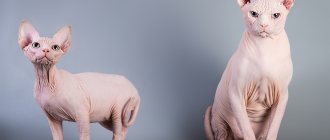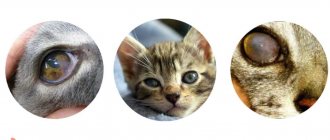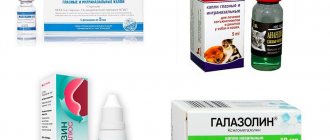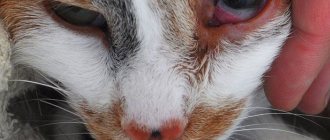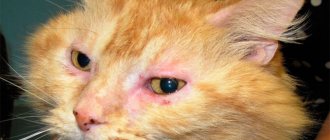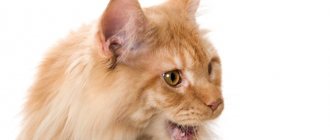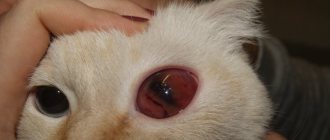Every pet owner must monitor the health of their pet. It is necessary not only to feed the cat well, but also to carry out hygiene procedures - bathe in a timely manner, clean the ears and wipe the eyes.
In the absence of hygiene, the pet often develops pathological processes in the eye area, causing the appearance of purulent exudate.
The main reason for the appearance of pus from the eyes of cats is inflammatory processes in the area of the conjunctival membrane, which were not eliminated in a timely manner.
The factor that provoked the development of the disease must be established in a veterinary clinic, where the animal will undergo all the necessary diagnostic procedures and be prescribed adequate treatment.
Causes of pus in the eyes of cats
All causes of eye suppuration in cats can be divided into several large groups:
- Mechanical damage to the retina. Accompanied by temporary inflammation followed by watery discharge. The latter accumulate in the inner corners of the eye in the form of small, hard brown or black lumps.
- Chemical exposure that causes an animal to develop blepharitis (inflammation of the edges of the eyelids).
- Colds or allergies are often accompanied by clear or white mucous discharge from the nose and eyes.
- The body's response to the action of pathogenic microorganisms. The discharge is yellowish-green in color and is recognized by the specific smell of pus.
- The result of a complication of conjunctivitis that occurs when a veterinarian is not consulted in a timely manner.
- Helminthiasis. In addition to the main parasitic factor, helminths poison the animal’s body with the products of their vital activity. As a result, an allergic reaction occurs, accompanied by mucus from the nose and suppuration of the eyes.
We recommend reading the article about eye diseases in cats to understand the topic in more detail.
Other causes of festering eyes
When the owner notices that the cat’s eyes are festering and the pet often sneezes, rubbing his nose from which snot flows, he can hardly immediately find out the cause of the sneezing and increased discharge. The same applies to the measures that need to be taken to stop the problem. Establishing the factor that caused this violation is a priority in this case.
Sneezing can be caused by ordinary dust. But if an animal sneezes constantly, this is an alarming symptom indicating illness and abnormalities in the body.
For example, if a cat has a runny nose and festering eyes, this is a common sign of a cold. It could also be an allergic manifestation to irritants or an infection.
Cat allergies are one of the most common causes of eye infections. Allergens are present everywhere:
- repellents for pests, mosquitoes, flies;
- perfume, household deodorants;
- cleaning and detergents;
- pollen of domestic plants;
- mold, fungi on the walls;
- cigarette smoke.
In addition to the main signs of allergies, such as when a cat’s eyes and nose fester, there are secondary symptoms of exposure to allergens:
- hoarse breathing;
- elevated temperature;
- general depressed state of the pet.
Each of these signs and all of them together is a reason to take the animal to the veterinary clinic. Doctors often encounter similar problems and know which antihistamine to prescribe when certain symptoms occur.
Important! It is worth understanding that if a cat’s eyes are festering due to allergies, it will not be possible to treat the problem with antihistamines. They temporarily stop the problem, but to save your pet from suffering forever, you will need to find the irritating allergen and get rid of it.
A cat's eyes fester for various reasons:
- poor health;
- reduced immunity;
- unkempt sleeping area;
- insufficiently balanced food.
Do not forget about hypothermia and drafts, because of which the cat’s eyes and snot fester especially often.
The first signs of a disease such as chlamydia are characterized by the appearance of purulent ichor and subsequent inflammation of the cornea and mucous membrane.
The next reason why a cat’s eye waters and festeres is atopic dermatitis. This is a seasonal disease of an allergic nature.
Do not discount such a factor as heredity. Cats whose family had ancestors suffering from eye diseases are at a special risk group; the likelihood of developing pathologies in these pets is 50% higher.
Sometimes it happens that the pet is apparently healthy. There are no visible symptoms of the disease, except for discharge, there are no secondary signs of infection or mechanical damage to the organ of vision. The tests also show a favorable result. Naturally, the owner of the animal has a reasonable question - why do the cat’s eyes fester if there is no reason for this.
In such cases, the answer must be looked for literally in the cat's eye. After all, the issue is most likely a congenital pathology:
- incorrectly located hair follicle;
- incorrect position of the lower eyelid;
- eyelashes in several rows;
- absence of lacrimal opening;
- lacrimal sac defect.
The animal, being a kitten, already begins to experience discomfort from the influence of the pathology, and with age and, as a consequence, an increase in the “defective area,” the symptoms become more pronounced. In our case, the cat’s eyes fester. What to do in this case is to solve the problem, usually surgically.
You cannot self-medicate; only a doctor can choose the right medications.
Symptoms
An experienced owner always pays attention to the behavior of his pet. Symptoms:
- Loss of appetite, general lethargy, increased sleep duration.
- Increased body temperature.
- Preference for dark, secluded places due to increased sensitivity to light.
- Squinting or closing your eyes most of the time.
- The presence of a specific odor.
- The appearance of a rare cough, redness of the mucous membrane, runny nose.
Conjunctivitis - features of the disease, main signs
Despite the considerable number of diseases that can cause sour eyes in pets, the most common cause of unpleasant symptoms is conjunctivitis. The disease begins to develop almost imperceptibly - swelling of the eyelids, redness of the eyeballs. Lack of treatment provokes more alarming symptoms - the cat's eyes turn brown. Timely intervention on the disease allows you to cope with unpleasant symptoms even without the use of aggressive drugs. If you are late in helping your pet, purulent discharge may appear, accompanied by an unpleasant odor. In such cases, you must immediately go to the veterinarian - you cannot do without therapy. Danger of disease - when a cat washes itself, it easily transfers the infection to the mucous membrane of a healthy eye. Infection does not occur immediately, so it is recommended to carry out prophylaxis during treatment to prevent infection of healthy tissues.
Diagnostics
If primary suppuration occurs, the owner should immediately contact a qualified specialist, preferably a specialist, an ophthalmologist. Time and strict adherence to the doctor’s instructions play an important role in the favorable outcome of treatment.
You should take eye diseases in newborn kittens especially seriously, because... complications later will pose an even greater danger.
Without laboratory tests and an integrated approach, it is impossible to be sure that the diagnosis is correct. Unfortunately, not all owners remember this, preferring self-medication at home to an experienced veterinarian.
What to choose for processing?
Antibacterial agents are selected for treatment, for example, a solution of furatsilin along with boric acid or special drops from any pet store. Under no circumstances should you use an alcohol solution, even a very diluted one with water. This not only provokes a new wave of pathological discharge, but can also damage the inflamed eye. You can prepare the medicinal composition yourself:
- Preparation of saline solution. Add a spoonful of salt to a liter of boiled water. Stir everything thoroughly and boil the resulting liquid. Before treating the eyes, the liquid is cooled to body temperature; it should not burn the skin. This solution can be used for any type of discharge, with the exception of allergic reactions. How to cure a kitten's eyes? We continue to consider this issue.
- Using a weak infusion of a medicinal plant. To prepare it, take two tablespoons of sage, pour boiling water over it (it is best to use distilled water) and keep the product in a water bath for 15 minutes. After this, everything is filtered through gauze, and the same thing is done a second time through cotton wool, then the product is diluted with water to obtain 500 ml of liquid. The medicine should be stored in the refrigerator, but not more than one day. This weak infusion is also used when allergies occur.
- Weak black tea is also suitable for rinsing. The caffeine it contains can have an anti-inflammatory effect and relieve the kitten's condition.
We suggest you read: How long do British breed cats live at home?
So, kittens’ eyes are festering, what should you do? The eyes need to be washed, as described below.
Treatment methods
It is important to remember that the success of recovery directly depends on the accuracy of the diagnosis and the person’s willingness to fully comply with the instructions.
Recommendations:
- For a complete diagnosis, the doctor requires an anamnesis, i.e. information about the cat: what conditions the pet lives in, its diet, previous diseases, behavioral characteristics, proximity to other animals.
- It is advisable to wash your cat’s eyes with a warm chamomile solution before visiting the veterinary clinic.
- Depending on the causes of suppuration, the doctor may use several treatment approaches. In case of prolonged and profuse discharge from the eyes and nose, as a rule, a novocaine blockade with the administration of an antibiotic is prescribed. If discharge from the eyes is the result of mechanical damage, use Levomycetin drops for an adult cat or Albucid for one-month-old kittens.
What does purulent discharge from a cat's eyes look like?
The purulent discharge from the eyes of a cat is opaque in appearance, has a viscous consistency, and has a yellowish or greenish color, which determines the appearance of the microflora that caused the formation of pus. Depending on the amount of discharge, it can be in the corners of the cat’s eyes, form streaks on his face and dry yellowish crusts, and also form cloudy filmy deposits on the conjunctiva.
The appearance of the eye changes, the most common are:
- redness of the conjunctiva and eyelids;
- swelling of the conjunctiva and eyelids;
- prolapse of the third eyelid on the affected eye;
- blepharospasm - narrowing of the palpebral fissure caused by protective contraction of the eye muscles;
- photophobia - the cat squints the affected eye when in the light, trying to find dark places.
The animal's behavior changes:
- the cat scratches its eyes with its paws and rubs its muzzle against surrounding objects;
- blinks frequently;
- sneezes rarely if this is due to part of the discharge entering the nasal cavity through the nasolacrimal duct, and often if purulent discharge from the eyes is associated with the development of an infectious disease;
- tries to hide in dark places;
- the cat is apathetic, does not want to play, and his appetite decreases.
Purulent discharge is opaque, viscous consistency, with a yellowish or greenish tint
List of recommended drugs
Based on the causes of the disease, the veterinarian most often prescribes the following medications:
- For bruises and injuries - drops of Levomycetin or Iris.
- For swelling - a solution of hydrocortisone and novocaine.
- For acute illness - intramuscular antibiotics.
Prescribing medications for an animal should only be done by a professional after a complete diagnosis. Self-treatment without the guidance of a veterinarian can lead to complications and irreversible pathologies.
Treatment of conjunctivitis
After making sure that sour eyes do not indicate the development of a viral or infectious disease, you need to help your pet cope with the inconvenience. Please note that self-treatment is acceptable if it helps, that is, you clearly observe positive dynamics. If your cat gets worse or does not see noticeable improvement within 3-4 days, contact your doctor. The absence of positive dynamics indicates that the regimen you have chosen does not destroy the causative agent of conjunctivitis.
When contacting a doctor, the type of pathogen is diagnosed, namely, washing off from the mucous membranes of the eyes. After examining the purulent discharge, it becomes clear what type of microorganism caused the disease. Identifying the exact cause makes it possible to treat with narrow-spectrum drugs that do not have a short list of side effects. Without a laboratory examination, the doctor will prescribe treatment with broad-spectrum drugs. Typically, drops are selected that will kill the majority of common microorganisms in a short time. If treatment does not give positive dynamics on days 2-3, the cat is examined more thoroughly to identify the root cause.
The traditional treatment algorithm is to maintain maximum cleanliness, eliminate reporting and irritation, and use eye drops. To keep the eyelids clean, your cat's eyes should be wiped with tea, freshly brewed chamomile or calendula. Prices for drops vary greatly; for example, broad-spectrum drugs can differ in cost by 10 times or more. The difference is noticeable in the speed of action, for example, using chloramphenicol drops, you will treat a cat for 3-4 days, the same ciprovet will remove all symptoms in 1-2 days. However, there is not much difference here either, since the minimum period of treatment, 5–7 days, must be carried out without fail, even if the symptoms have completely disappeared.
Important! If your pet is prone to allergies or belongs to breeds with a short muzzle, be sure to consult a doctor before starting medication treatment.
Tips for beginners when washing eyes
Eye washing is one of the most important points in the treatment and prevention of disease in any animal.
You can do the procedure yourself at home or go to a veterinary clinic. During a period of illness, a cat is most often reluctant to allow its owner to approach it.
Representatives of the Persian, British and Siamese breeds are especially capricious. In this situation, it is advisable to ask a family member to hold the cat's head during the procedure. It is best to secure it with a towel or diaper.
Recommendations:
- A folded cotton pad or a tight tourniquet is suitable for rinsing. It is better to avoid cotton swabs, as they do not absorb liquid well, have a relatively small surface and can damage the retina when the animal tries to escape.
- For sterility purposes, it is better to prepare separate dishes for washing each eye. For the same reason, you should use a cotton pad no more than once.
- It is not recommended to touch the inflamed surface with a dry disc.
- Hands must be washed.
- All solutions must be at room temperature.
- Keep in mind that a swollen area can often cause pain for your cat.
- The best treatment is comprehensive. After rinsing with the solution/drops, re-treat the inflamed area with ointment.
- You need to repeat washing as often as possible. Step-by-step instructions for washing eyes
- Fix the animal on its side, turning its head up, holding the chin.
- If a crust forms and the eye sticks together, soften the inflamed area with Vaseline oil. Using cotton wool soaked in 3% hydrogen peroxide, remove the discharge, then rinse with the solution and apply eye drops.
- Apply the solution to the eyeball, gently lifting the eyelids.
- Raise and lower the animal's eyelids several times to distribute the medication evenly. Remove excess with a disc.
- Do not forget about nasal discharge, remove it with a cotton pad.
What to do at home
The owner must follow the veterinarian's instructions. Self-medication is dangerous and can make the situation worse.
You can wash your cat's eyes with chamomile decoction, boric acid solution, or furatsilin. The pet is unlikely to accept this manipulation with delight, so it is advisable to perform the procedure together: one person holds the cat, the second treats its eyes, and then instills the drug.
The solution used must be warm. Rinsing is carried out with a cotton pad, twisted into a tourniquet, until the pus from the eye is completely removed. Only after this the drug is used.
You cannot use a dry pad or cotton swabs, as they can injure your eyesight.
Types of tinctures and solutions
Eye solution can be purchased at a pharmacy or prepared independently.
The most effective are:
- Camomile tea. Dilute one tablespoon of dried flowers in a glass of boiling water. Leave for 30 minutes.
- A decoction of strong tea. It is advisable to use whole leaves and distilled water.
- Table salt solution. For a liter of distilled water, take 1/2 teaspoon of salt. The mixture is brought to a boil. Not suitable in case of an allergic reaction.
- Lacrimin or Medkinos solutions, which can always be purchased at a pharmacy at an affordable price.
Injuries and irritations
Like any other creature, a cat can get injured in everyday life. A speck of dust or other foreign body may get into the eye, or the animal may accidentally damage the eye with its paw. In most cases, a minor injury is harmless and does not cause much discomfort. The eyes are watery and there may be some redness, but there are no more severe symptoms and the cat is acting normally.
The same can be observed when the mucous membrane of the eyes is irritated by household chemicals or when interacting with an allergen. Quite often, domestic cats come into contact with cleaning products that contain irritants. Curiosity literally kills the cat, and chemicals or cosmetics get into the eyes.
With short contact with the allergen, the same symptoms appear - slight redness of the eye and profuse lacrimation. In this case, tears act as a natural cleanser and simply wash away the remaining irritants from the mucous membrane, stimulating its rapid recovery. Usually this phenomenon occurs within a few hours and goes away on its own.
Plant pollen, fluff, and feathers from pillows can also act as an irritant. As a rule, the eyes do not water as a result of a food allergic reaction, but this possibility cannot be completely ruled out. If your cat’s eyes water profusely immediately after changing the diet, it is recommended to return to the previously used food and observe the behavior of your pet.
Choosing eye drops
Unlike infusions, it is impossible to prepare drops at home. You can find the necessary remedy at a veterinary or regular pharmacy.
It is important to remember that neither solutions nor drops can provide a 100% healing effect. The latter are necessary only to slow down the development of the disease.
The most commonly prescribed drugs are:
- Sulfacetamide.
- Levomycetin drops.
- Diamond eyes.
How to wipe and rinse a cat's eyes
When the doctor has already prescribed treatment for the cat’s eyes and the procedures are carried out at home, it will not be a bad idea to read the short instructions.
You need to prepare:
- several gauze napkins/cotton pads;
- pipette/disposable syringe;
- towel;
- delicacy!
Action 1.
It is necessary to catch and secure the pet, wrap it in a towel. If the procedure is being carried out for the first time, then it would be quite appropriate to invite other family members to provide assistance, since the animal in panic may begin to break out with a force that the owner had no idea about before. The presence of a towel is necessary so that a desperately resisting cat does not injure its owner. As a rule, pets do not really like various kinds of manipulations.
Action 2.
A number of necessary manipulations should begin. A napkin or cotton pad should be soaked in the medicinal solution, soak the crusts and remove them.
Action 3.
You need to take a new cotton pad or napkin and soak it in the medicinal solution. Using your thumb and index finger, separate your eyelids and rinse them, moving from the outer corner of the eye to the inner. You need to try to wet the conjunctiva generously with the solution. If you have sufficient experience, the rinsing procedure can be carried out using a disposable syringe (without a needle), injecting the solution directly under the eyelids.
Action 4.
You need to blot your pet's eyes with a dry and clean napkin or cotton pad.
Action 5.
Next, you should appease your pet with his favorite treat. Surely, performing these procedures became stressful for him. If the animal is very offended, you can add a double portion of treats.
In conclusion, it must be said that regular eye hygiene, fur care, teeth cleaning, manicure/pedicure should become a number of familiar procedures for your pet fluffy.
Tags: Health, Treatment, Veterinarians' opinion, Disease prevention
Selection of ointments and method of their use
For best effect, it is recommended to use ointments. As a rule, tetracycline ointment (1%) is used.
Apply it as follows:
- First, purulent discharge from the eyes and nose is removed. Gently wash the inflamed areas with a cotton pad soaked in tincture or solution.
- To enhance the effect, the ointment is warmed to room temperature in advance.
- Lightly pull back the cat's lower eyelid, apply ointment to its inner surface, placing the latter with a special spatula.
- The eyelids are closed, massaging in a circular motion to better distribute the ointment over the surface of the swollen eye.
- Remove excess with a cotton pad.
What diseases can cause your eyes to fester?
Purulent discharge from the eyes is a symptom of both eye diseases and general diseases.
Common diseases accompanied by purulent discharge from the eyes
Common diseases that cause cat eyes to fester:
- Allergy - at the beginning of the disease, the discharge is mucous in nature, bilateral in nature, which changes to purulent with the addition of secondary microbial flora. Additionally observed: sneezing;
- nasal discharge;
- redness of the conjunctiva;
- skin rash.
- instability of appetite;
- panleukopenia: sudden fever up to 40–41 ° C;
- fever;
- fever;
- periodic fever;
- at the very beginning of the disease, the purulent discharge is unilateral, later the second eye is affected;
Chemosis is the predominant symptom when the conjunctiva is affected by chlamydia
- fever;
- sneezing, coughing;
Photo gallery: systemic diseases in which purulent discharge from the eyes is observed
Panleukopenia causes profuse purulent discharge from the eyes and nose.
With herpetic conjunctivitis, the discharge from the eyes is purulent in nature
With chlamydia, purulent discharge from the eyes is typical, as well as chemosis - swelling of the conjunctiva
Measures to improve the condition of the conjunctiva
In case of general diseases, purulent discharge from the eyes is treated only together with the underlying pathology of which they are a symptom. To improve the condition of the eyes in case of general diseases, the following are used as part of complex therapy:
- Regular toilet of the eyes to remove pus and microbial accumulations using hygienic eye lotions: Klini;
- Veda;
- Dewdrop.
- Tsiprovet;
- tetracycline ophthalmic;
- Forvet;
Anandin is a drug that has anti-inflammatory, antiviral and immunomodulatory effects.
Table: eye diseases with purulent discharge
| Type of disease | Symptoms | Treatment |
| Eye injury |
|
|
| Conjunctivitis is an inflammation of the conjunctiva and eyelids, which is unilateral or bilateral. |
|
|
| Keratitis - inflammation of the cornea |
|
|
| Blepharitis - inflammation of the eyelids |
|
|
| Uveitis - inflammation of the choroid of the eye |
|
|
| Entropion is a chronic injury to the surface of the eye by the edge of the deformed eyelid, as well as by its eyelashes. |
| Surgical restoration of the correct position of the eyelid |
| Dacryocystitis - inflammation of the lacrimal sac |
|
|
Thus, purulent discharge from a cat’s eyes may indicate both the presence of a systemic disease and the development of eye disease. Moreover, purulent inflammation can mask the primary nature of the process and return after the use of antibiotics without treating the underlying cause of the disease.
Photo gallery: eye diseases that cause purulent discharge from the eyes
Purulent discharge from the eyes in cats most often occurs due to conjunctivitis.
Keratitis is characterized by clouding of the cornea. Dacryocystitis is characterized by swelling at the inner corner of the eye.
Entropion of the eyelid is treated surgically
Table: drugs that are used to treat eyes in cats with purulent discharge
| A drug | Compound | Operating principle | Application | Price, rubles |
| Ophthalmosan, eye drops |
| Bactericidal, anti-inflammatory, decongestant |
| 185 |
| Leopard, eye drops |
| Antibacterial agent |
Instill 1-2 drops 3-4 times a day for a course of 1-2 weeks. | 159 |
| Ciprovet, eye drops | Ciprofloxacin | Antibacterial agent |
Instill 1 drop 4 times a day for 1–2 weeks. | 196 |
| Tetracycline eye ointment | Tetracycline | Antibacterial agent | Infectious eye diseases caused by pathogens sensitive to tetracycline. Apply 3–5 times a day. | from 44 |
| Maksidin 0.15, eye drops | Germanium bis(pyridine-2,6-dicarboxylate) |
| Treatment of conjunctivitis and keratoconjunctivitis. Apply 1 drop 2-3 times a day for a course of no more than 2 weeks. | 52 per bottle |
Photo gallery for the treatment of eye diseases with purulent discharge
Sinulox is used for systemic antibacterial therapy for infectious eye diseases.
Tetracycline ointment has a broad spectrum of action and is used to treat both bacterial conjunctivitis and chlamydia
Bars eye drops are a combined antibacterial drug with an extended spectrum of action.
Korneregel promotes corneal healing
Maxidin is a veterinary drug that is used for immunocorrection in the fight against diseases of viral origin.
Dekta-2 eye drops are intended for the treatment and prevention of ophthalmic diseases of bacterial origin in pets
Ciprovet for cats is an effective antibacterial drug with a complex spectrum of action.
How to treat a cat's eyes
To carry out treatment procedures, it is better to use the help of an assistant who would hold the cat. If there is no assistant, the cat is immobilized, swaddled in a towel.
The following treatment procedures are carried out at home:
- Eye rinsing: a napkin is moistened with eye lotion or an antiseptic solution and passed over closed eyelids, removing secretions;
- if the eyelids are stuck together, a napkin richly moistened with an antiseptic solution is applied to them and lightly pressed, after which the eye will open, you cannot use force to open the eye, you can damage the eyelids;
- You cannot touch the surface of the eye with a napkin; it is washed with an antiseptic solution from a syringe, after removing the needle.
Since ointments and drops are irritating, it makes sense to wear a protective (Elizabethan) collar on the cat to prevent scratching of the eyes with its paws.
Protective collar prevents paws from scratching your eyes
Video: how to care for your pet's eyes
Preventive measures necessary to avoid eye diseases
Vaccinations and periodic deworming are universal ways to protect any animal. It is also important to consider the breed of the cat.
Some of them, such as the Sphynx, require increased attention to the skin. Having no fur, they are more susceptible to suppuration. Not only do they require daily care and eye washing, but they also need to repeatedly wipe their ears with a warm solution.
The opposite situation is the Persian breed with thick hair. In case of suppuration, snot and other mucous secretions, you should cut off the hair around the swollen organ and, after recovery, carefully ensure that the hair does not fall into the area of the former inflammation.
If infected, you should not allow the infectious animal to come into contact with your child or healthy pets; it is also important to remember your own safety measures when treating your eyes.
If the cause of eye discharge is an injury, then it is better to make an appointment with a veterinarian, undergo a full course of treatment, and also see a doctor regularly after that (preferably every month).
Daily animal care is the key to health. As a rule, it is difficult to train an adult cat to wash its eyes. However, for some breeds such safety measures are simply necessary due to their anatomical features, for example, Scottish Folds. Therefore, it is better to accustom your cat to such procedures from the first weeks of life.
How to treat a cat's eye when injured
If a cat's eye is swollen and festering after the pet visited the street, it may be due to injury. The animal could have gotten into a fight or injured its organ of vision on a twig. Most often in these cases, people start thinking about brilliant green or iodine. What can I say - this processing is acceptable, but it can only be trusted to a qualified person. After all, these liquids, if they get on the conjunctiva, can cause a painful shock in the animal and, worse, lead to irreversible pathological processes in the eye.
The next point is what to do if the organ of vision is also swollen. If a cat's eye is swollen and festering, there is a reason for this. For example, the combination of a swollen eye and oozing exudate often indicates that a foreign object has entered the eye area. In this case, it is not advisable to help the animal “at home”. After all, you don’t know what exactly got into your pet’s eye, what if it’s a thorn that pierced the cornea. Accordingly, removing a foreign object can lead to increased damage, which will definitely harm the animal.
Inflammation of the cornea is a little more harmless. If the disease is acute, then the cat’s eyes fester greatly, in this case you already know what to do - go to the veterinarian.
Street cats
The reason for the prevalence of eye diseases among street cats is the lack of normal living conditions. Frequent fights, lack of medication, constant contact with other animals, poor diet, temperature changes and other factors cannot have a beneficial effect on recovery. As a rule, environmental conditions only aggravate the situation and lead to serious consequences.
Adopting a stray cat is easy. However, one should always be aware of the level of responsibility that a person takes on with such a decision.
In most cases, street cat diseases are in late stages, so the treatment period can take a long time and cost a lot of money.
At the same time, homeless animals are the most loyal creatures in the world, unlike many purebred animals. Such a cat will be grateful to its owner and can become his best friend.
Colds and lacrimation
A cat's eyes may become watery as a result of ordinary hypothermia or a cold. Watery eyes may appear due to a runny nose, excessive sneezing, or inflammation of the middle ear (otitis media). Since all of these diseases are often related, it can be difficult to pinpoint the exact cause of tear production.
Possible risks can be assessed by observing the animal. If the cat is lethargic, sleepy, but does not lose its appetite and willingly contacts people and other animals in the house, we are talking about normal hypothermia or a cold. In this case, the pet needs warmth and peace. This condition can be dangerous for older animals and very young kittens, but the body of an adult and healthy cat will recover on its own.
You should consult a doctor if your cat refuses food or water or experiences vomiting or diarrhea. These symptoms may indicate a virus, parasite infestation, or bacterial infection.
In older cats, excessive lacrimation may be normal, but also the first symptom of developing cataracts. In the first case, severe dry eyes are observed due to the microclimate in the house, and the secretion of tears acts as a natural mechanism for moistening the mucous membrane. In the second case, in addition to lacrimation, clouding of the cornea is observed.
Only a specialist can accurately determine the cause of this phenomenon, so the task of a loving owner is to show the pet to a veterinarian in a timely manner.
In order for your pet to get sick less often, he needs to take preventive measures, namely:
- A small pet should wash its eyes daily;
- When playing with an animal, it is necessary to take all measures so that the kitten does not get injured;
- All vaccinations must be done on time;
- The animal's nutrition must be correct and balanced;
- Take your pet to the vet regularly.
Caring for your pet is a very important aspect of pet care. After all, this is the only way your baby will grow up healthy and happy.
